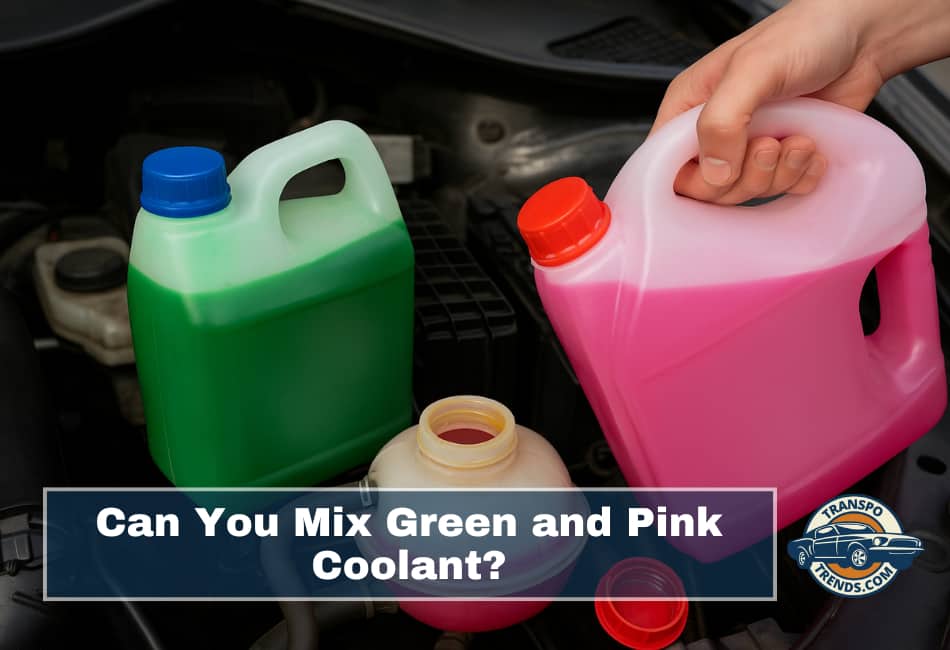Your car’s engine is a symphony of metal, heat, and motion—an orchestra that only performs well when every component is in tune.
At the heart of this performance is your vehicle’s cooling system, quietly working to prevent catastrophe. The unsung hero? Coolant. Or as some call it, antifreeze.
It prevents overheating in summer, freezing in winter, and corrosion year-round. But not all coolants are the same.
If you have ever peered into your coolant reservoir and wondered, “Can I top off the pink stuff with the green one I have in the garage?”—this article is your wake-up call.
Mixing green and pink coolant may seem harmless, but it can cause severe problems that you might not see coming until it is too late.
Let us walk through everything you need to know about these two colorful fluids—how they work, why they are different, and exactly what happens when you combine them.
1. Green vs. Pink Coolant: What Sets Them Apart?
Coolant color is not just for show. It often hints at the chemistry behind the fluid.
- Green Coolant: This classic green fluid is usually based on Inorganic Additive Technology (IAT). Think of it as the old-school protector of older engines—vehicles built before the mid-1990s. It contains silicates and phosphates to prevent corrosion, but it has a shorter lifespan—about 2 years or 30,000 miles.
- Pink Coolant: This modern solution is based on Organic Acid Technology (OAT) or Hybrid Organic Acid Technology (HOAT). It is designed for newer engines—especially those with aluminum and plastic components—and offers longer protection, lasting 5 years or 150,000 miles or more. You’ll find it in many European and Asian vehicles like Volkswagen, Mercedes-Benz, and Toyota.
So far, so good. But the issue starts when these two types meet.
What Happens When You Mix Green and Pink Coolants?
Mixing green and pink coolant may seem like a shortcut, but the results are almost never good.
Chemical Clash
The green coolant’s silicates and phosphates do not play well with the organic acids found in pink coolant. When mixed, they can create a thick, sludgy gel. That sludge can block your radiator, your heater core, or your water pump, stopping coolant from flowing freely.
And when coolant cannot circulate, your engine heats up fast—and not in a good way.
According to Prestone UK, mixing incompatible coolants can have “catastrophic” consequences for your cooling system.
Corrosion Nightmare
Coolants protect specific engine materials. Green coolant guards iron and older-style aluminum radiators. Pink coolant is built for modern components—lightweight aluminum, plastic water pumps, composite manifolds.
When you mix the two, you dilute their protection power. The result? Corrosion eats away at your engine from the inside out.
Shortened Life Expectancy
You are also reducing the life of your coolant. Mixing a 2-year coolant with a 5-year one does not give you the best of both worlds—it drags everything down to the lowest common denominator.
Your cooling system might now need flushing after just 30,000 miles, rather than lasting the full 150,000 miles pink coolant is designed for.
Can You Ever Mix Them Safely?
Here is the short answer: no. If your coolant reservoir is low and you only have the wrong type of coolant, do not pour it in and hope for the best.
Use the Same Coolant Type
The first rule of thumb—always stick with the type recommended by your vehicle manufacturer. Your owner’s manual will tell you exactly which coolant to use. If your car came with pink OAT coolant, refill it with the same. If it came with green IAT, match it accordingly.
Even better, use the same brand if possible. Not all coolants with the same base technology are formulated the same way.
Distilled Water as a Temporary Fix
In an emergency, distilled water is a safer temporary top-up than mixing different coolants. It lacks the protective properties of antifreeze, but it will not cause sludge or chemical reactions. Just be sure to do a proper flush and refill with the correct coolant as soon as you can.
Already Mixed Them? Here Is What to Do
Accidents happen. Maybe you bought a used car and do not know its coolant history. Maybe a mechanic topped it off with the wrong fluid. Maybe you made the mistake yourself. Here is what to do.
Flush the System
Flushing is not optional—it is essential. You need to remove every trace of the mixed coolant to prevent sludge formation.
A professional flush by a mechanic is your best bet, but you can also perform it at home if you have the right tools and follow proper safety procedures.
The entire system—radiator, heater core, water pump, and hoses—needs to be flushed until only clean distilled water comes out. Then refill with the correct coolant.
Why Automakers Are Picky About Coolant
Your car’s warranty may depend on it. Automakers carefully design engines to work with specific coolant formulations.
Mixing the wrong type can void your warranty. If a failure occurs and the dealership finds mixed or incorrect coolant, they may reject your repair claim—even if it is unrelated.
Beyond warranties, correct coolant use ensures proper performance. Engines today run hotter, are packed tighter, and use more lightweight materials than ever before. The right coolant is not just a preference—it is a necessity.
How to Maintain Your Cooling System the Right Way
Proper coolant management is not just about what goes in—it is about what you do over time.
- Follow Manufacturer Intervals: Replace your coolant every 2–5 years, depending on the type. Your owner’s manual will give you a service schedule. Stick to it.
- Inspect the System: Check coolant levels monthly. Look for leaks, rusty water, or unusual smells. These are signs something is wrong.
- Never Mix Coolant Types: Even if the colors look similar, the chemistry may not be. Do not assume that red and pink are the same. They often are not.
- Consider a Universal Coolant: If you are unsure about your vehicle’s history, you can use a high-performance universal coolant like Prestone All Vehicles formula. It is compatible with all makes and models and protects for up to 300,000 miles.
Why This Matters More Than You Think
Here is the bottom line—coolant may not be as flashy as horsepower, torque, or zero-to-sixty times, but it is just as critical.
A single mistake, like mixing incompatible coolants, can lead to costly repairs. We are talking about hundreds or even thousands of dollars to replace a clogged radiator, failed water pump, or cracked engine block.
Taking a few minutes to double-check your coolant type or to flush the system properly is a simple, affordable act of preventative care that could save you a lot of money—and a major headache—down the road.
Green vs. Pink Coolant
To drive this home, here is a side-by-side comparison:
| Feature | Green Coolant (IAT) | Pink Coolant (OAT/HOAT) |
|---|---|---|
| Chemical Base | Inorganic (silicates, phosphates) | Organic acids (silicate-free) |
| Lifespan | ~2 years or 30,000 miles | ~5 years or 150,000 miles |
| Ideal For | Older vehicles (pre-1990s) | Newer European/Asian vehicles |
| Corrosion Protection | Iron, traditional aluminum radiators | Aluminum/plastic components |
| Mixing Risk | Sludge and clogs if mixed | Loses effectiveness if mixed |
| Warranty Risk | High if not used as specified | High if mixed incorrectly |
Final Thoughts
Mixing green and pink coolant is like trying to blend two different operating systems—it may seem like it could work, but it introduces more problems than solutions.
If you care about your engine, your wallet, and your vehicle’s longevity, stick to the basics: use the coolant recommended by your manufacturer, never mix types, and flush the system when in doubt.
By making smart choices now, you protect your vehicle from costly issues in the future.

